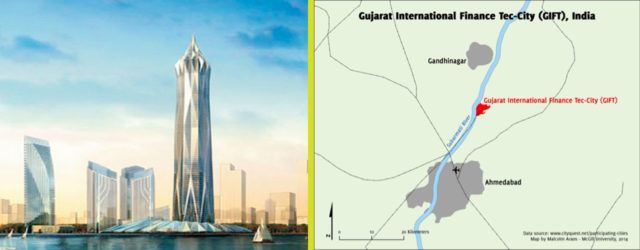Gujarat: India’s New Global Financial and IT Hub
November 27, 2014 — Blog
Gujarat International Finance Tec-City (GIFT) is being designed as a global financial and IT services hub. Located in Gujarat, a prosperous state in far western India, between the state capital of Gandhinagar and the commercial hub of Ahmedabad, GIFT seeks to feed off the economic drivers of each city. Some of the key ambitions for the city include:
- Zero accidental deaths – no bicycle, car, or pedestrian accidents
- Using the city surface strictly for people and putting transportation and infrastructure underground
- The ability for residents to travel between any two points in the city in 10 minutes
- Providing potable tap water to prevent the use of bottled water
- A rapid response system using an urban control center to monitor potential problems
- Providing social, human spaces of varying scales for a range of recreational activities
- Creating different ‘zones’ to cater to various institutions (education, entertainment etc) to promote employment and attract talent.
Creating a ‘zero-dig’ city, in which the city’s connector tissue is bundled together in service trenches so the city will not need to be dug up after it is built.

Key Facts
Timeframe: 2007-2027
Intended population: 50,000 (600,000 commuters)
Size: 3.99 square kilometers
Estimated cost: USD $11 billion
Financing: The primary investors are Gujarat International Finance Tec-City Company Limited (GIFTCL), Infrastructure Leasing & Financial Services, and Gujarat Urban Development Co. Ltd (GUDC). GIFTCL plans to develop, finance, and implement all infrastructure in and around GIFT on a turnkey basis to ensure that all services relating to connectivity, communication, technology, security, and quality of life are established and sustained.
Planners / contractors: GIFT is being designed by the Fairwood Group as the lead designer. The Fairwood Group led a consortium of 43 partners, contributing the bulk of the design effort with 18 teams. East China Architectural Design & Research Institute (ECADI) is one of the Consortium partners. Other designers were Tongji (China), Forum (Singapore), ABB (Germany), Louis Berger (US), Stanley (US), IL&FS Eco-smart (India), CES (India), Spectral (India), British Telecom (UK), and Ultra PRT (UK), with Mackenzie and Hewitt as additional consultants.
Environmental and sustainability strategies: GIFT is planning a captive power plant (1000MW electricity supply), power grid (by ABB Group of Switzerland), underground electricity cables, natural gas distributed via pipes (safer and cheaper than cylinders), district (centralized) cooling, green buildings that feature solar water heating and rain water harvesting, 65% green cover, zero discharge for the city, a waste to energy system, no garbage trucks or garbage collection, and a PRT (personal rapid transit) system.
Industries: GIFT intends to be a hub for the global finance services industry and will create a stock exchange. They also seek to attract global banks and software and technology companies.
Attractivity: It is expected that in the context of India, high quality physical infrastructure (roads, electricity, water, broadband, etc.) will be able to attract a great number of finance and tech firms to relocate their operations from Mumbai, Bangalore, and Gurgaon, all of which have expensive or inadequate infrastructure. As a Special Economic Zone, GIFT also seeks to attract companies that want to take advantage of its more business-friendly regulatory environment. Lifestyle features such as parks and a traffic-free environment will ideally attract people who wish to get away from the crowding and traffic typically found in Indian cities.
Local challenges:
- Land scarcity and a potentially large population means that people will need to live more vertically than they have traditionally.
- The multiple permits required by various levels of government are slowing down the process of creating the city.
- Trying to involve the public to help determine the order of development has been difficult and time consuming.
- Attracting financing has been a challenge, as money is attracted to a success story that has already been built, rather than a computer model.
This post is part of a series tied to Cityquest – KAEC Forum, our leadership event on new cities. Each week, we’ll publish extracts from the report from our inaugural Cityquest event in 2013. Access the full report here.